Irises are beautiful flowers with an unusual shape of buds and leaves. Today, gardeners often use these flowers to form flower beds and flower beds, combining species with different colors of petals.
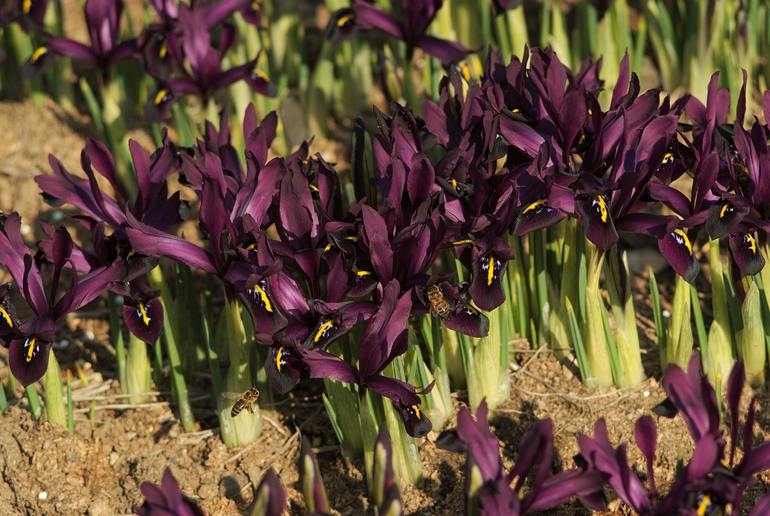
To make the flower beds look neat, and the flowers grow better, it is necessary to transplant irises in the fall. Growing in one place for more than five years, irises become less decorative.
Content
Time and reasons for transplantation
Irises grow rapidly, therefore, periodically need seating. Perform this procedure every year is not necessary, it is enough to carry out it every 3-4 years. Transplantation will relieve the plant of old roots, which will lead to the rapid development of new root shoots. Thanks to this, the iris will actively bloom.
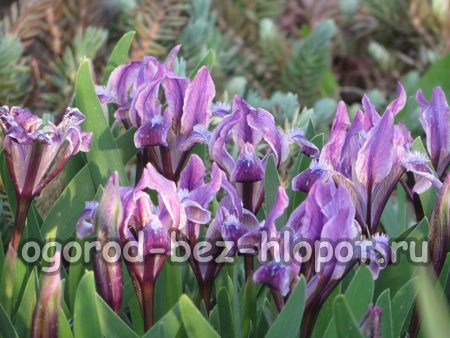 You may be interested in:
You may be interested in:To answer the question of when to plant irises in spring, autumn or summer, you should understand the characteristics of the vegetative period of the plant. It is divided into several stages:
- With the onset of spring, irises begin active growth of the aerial part, which lasts 1−1.5 months. During this time, the plant turns into a lush bush with buds.
- May - June is the period of flowering.
- In early July, a period of active growth of the root system begins, which lasts until the end of August. During this period, new links are fully formed, which next year will give new shoots.
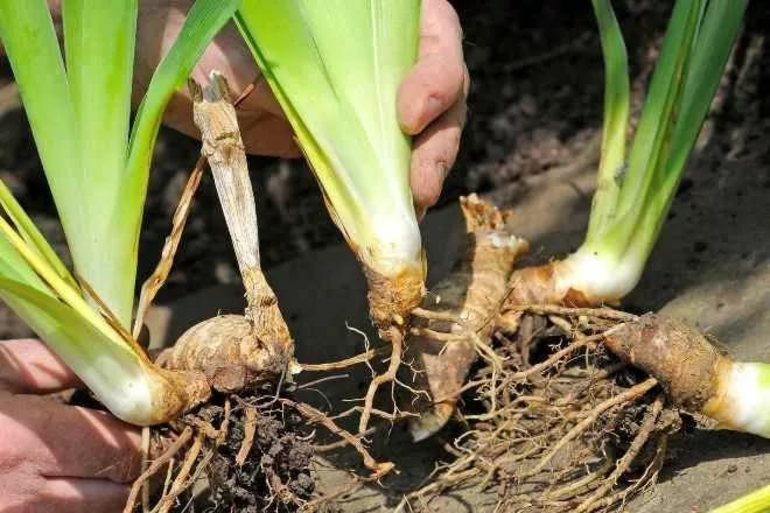
Thus, a spring transplant is undesirable. If you carry out the procedure, the plant will spend all its strength on adaptation and rooting, which means that it will not be able to sufficiently develop the aerial part. The usual vegetation will be disturbed, the plant will not bloom this year.
A transplant in the summer is also not recommended, since new root shoots appear during this period.
Gardeners claim that irises can be transplanted in the fall. The ideal period for this is called the end of August - September.when the root system is fully formed and can be easily divided into links. If you follow all the rules of transplantation, a small seedling planted in the fall will turn into a lush flowering bush next spring.
The main thing in transplanting irises in the fall is to guess the timing so that the plant has time to grow stronger before the onset of cold weather. It is believed that it should be moved to a new place 5-6 weeks before the onset of persistent frost. Therefore, the optimal time for transplantation in the northern regions is called the end of August, in temperate latitudes - the beginning and mid-September, in the southern regions, transplantation is possible until the end of October.
Site selection and preparation
Irises love sunlight. Therefore, you need to choose for their landing a place well lit (especially in the morning). It is better if it is a site on a small hill with a slight slope to the south. It will be well lit, and excess water will easily drain from it.
Irises do not like overly moist soils and close groundwater, because plants have a superficial root system. If there is a need to transplant flowers on moist soil, then it is necessary to lay a drainage layer. In addition to light and humidity, you should pay attention to whether the wind is blown away. A favorable condition for irises will be a place closed from the cold and gusty wind.
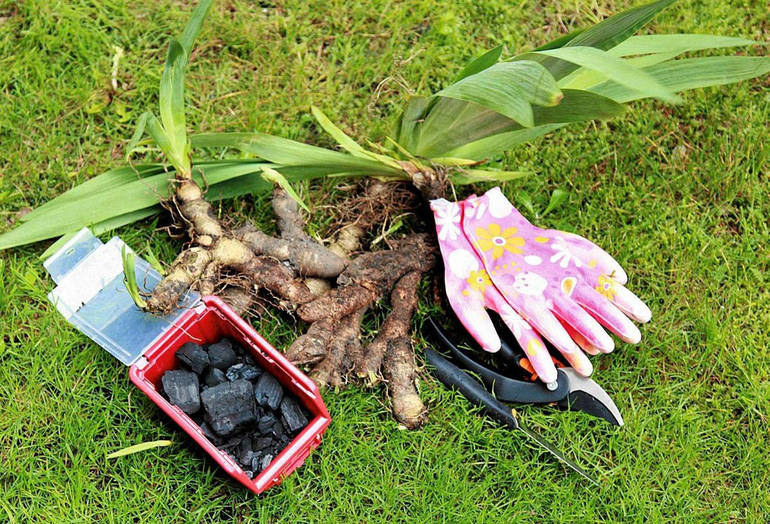
Irises grow well on loamy or loamy, slightly acidic soil. If the soil is very heavy and dense, it is worth adding a little sand or peat to it. Conversely, if the soil is too loose and light, a little clay should be added to it. It is recommended to add some wood ash or ground chalk to acidic soil.
Before proceeding with transplantation, it should also be applied to the soil in the selected area. some potash fertilizers and superphosphates. It is not recommended to introduce growth stimulants during transplantation and immediately after it, since they will only harm the development of the root system and adaptation. It is also not recommended to use manure as a fertilizer, since it can lead to burns on the measles system and the root neck of irises.
The soil on the site should be prepared in advance - 10−20 days before transplanting. During this time, it should be abundantly watered 3-4 times, preferably after the last watering, cover the area with film.
Stages of the procedure
About 2 weeks before transplanting, irises should not be watered or fertilized so that the flowers quickly adapt to a new place. Leaves of selected plants should be trimmed to about 1/3 of their length. This should be done in such a way that the shape of the slice resembles the roof of a house. It is not worth it to completely remove the leaves, since the process of photosynthesis in them continues until the frosts. The plant is divided into delenki - single units of the root system with a diameter of 1-2 cm and a length of 3-5 cm. Irises of different varieties can be signed with a marker on the remaining foliage.
Delenka for disinfection is soaked for 20-30 minutes in a weak solution of potassium permanganate, after which you can begin to plant. Process steps:
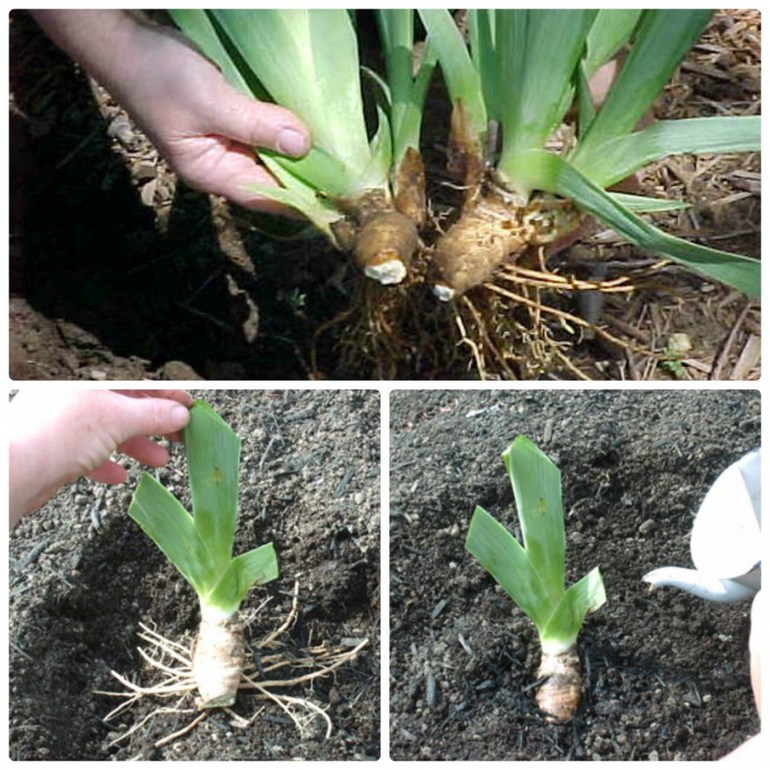
- Dig a landing hole 10-15 cm deep.
- Form a mound about 3 cm high in the center of the hole.
- Place the divide on the knoll, spread the roots along the slopes of the knoll.
- Sprinkle the roots with soil so that part of the rhizome remains on the surface, compact the soil.
- Water abundantly (about 500 ml of water will be required per bush).
Between the holes should leave a distance of 10-50 cm (depending on the variety and frequency of planting). A transplant is best done on a dry, warm day.
Aftercare
In order for irises to take root faster and better prepare for the approaching cold, they should not be watered often after transplanting. Additional pruning of leaves is not necessary, since it is expected at the stage of preparation for transplantation.
After planting, the tips of the leaves may turn a little yellow, this is a normal reaction of the plant, which only says that the iris is adapting to new conditions.
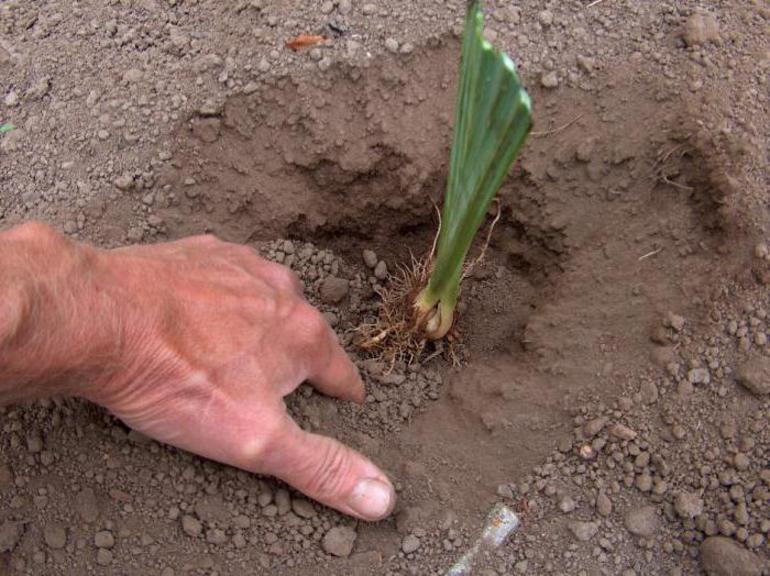
In the southern regions, there is no need to warm irises for the winter. In the northern and temperate latitudes, it is enough to mulch them with peat, sawdust, straw or just to spud. You need to do this only when the average daily temperature is below +5 ° C, otherwise the root system may rot. In spring, as soon as the snow melts, the covering material should be removed.
An important point is prevention the appearance of diseases and pests during transplantation and after it. Firstly, gardeners advise transplanting irises for this purpose on a site where they have not grown the previous 5 years. Secondly, do not forget about the disinfection of delenok with a solution of potassium permanganate or ash.
It is not necessary to feed irises in the fall after transplantation; they will need enough fertilizers that were introduced into the soil before planting. The first feed should be done in early spring before the buds appear. During this period, it is recommended to use nitrogen-containing fertilizers, which stimulate the active growth of the aerial parts of plants.
Blooming irises, especially when combining several species, look very beautiful. They unpretentious in leavingresistant to frost. To bloom was magnificent, you should periodically plant irises in the autumn. To do this is quite simple, so even beginner gardeners will cope with the process. The plant quickly adapts and in just one season it transforms from a small seedling into a lush flower with several buds.

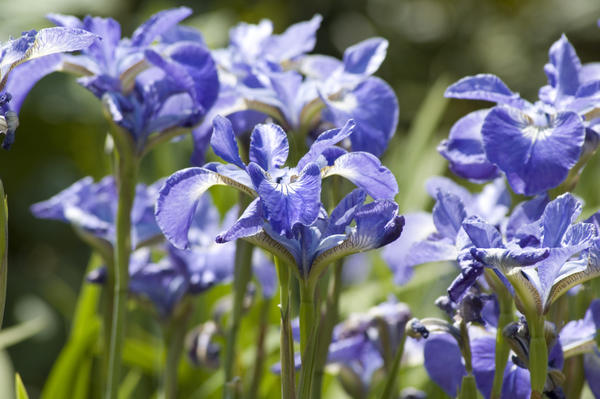 How to care for Siberian iris in open ground
How to care for Siberian iris in open ground